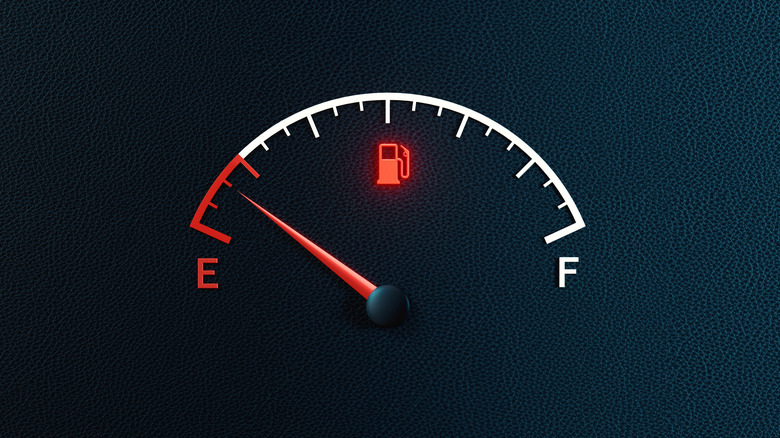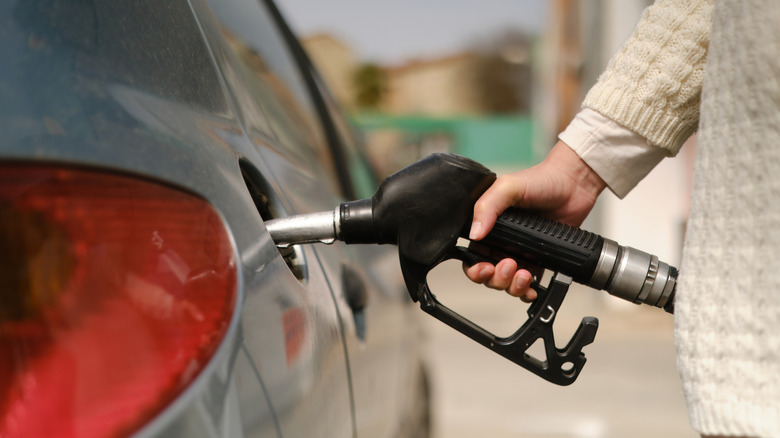How Far Can You Drive On Zero Miles To Empty?
We've all been there, whether it's on an epic road trip or a hectic work week where you've simply forgotten to fuel up: the dreaded flashing gas light on the dash. There are few things worse than being on the road with not many gas stations nearby, having to "run on fumes." If you're left without a choice, lest you pull over and call AAA, you may be faced with this conundrum: how far can you drive on empty? Each car will present a different answer, combined with factors like the environment, the quality of gas used, tank size, and the condition of the car or truck itself. Perhaps some of you have had to find out the hard way, while others may have pulled a Houdini, going well beyond the constraints of what is considered "empty," escaping roadside peril.
Driving on empty encompasses many factors, including the distance some vehicles will allow drivers to push past low fuel warnings, gas tank capacities compared to reserves, and potential damage to a car's systems. While driving beyond that critical "empty" status is never recommended, it can — and likely will — happen to all of us. But there are ways to mitigate that and avoid harming your car's engine, roadside stoppages, and hefty tow truck fees if you end up in that stressful, low-gas danger zone.
Understanding your vehicle's fuel reserve
Your vehicle has a "DTE" — distance to empty — which is calculated by the onboard computer, measuring the level of fuel remaining in the tank, combined with your recent average fuel economy. The distance you can drive to empty is constantly changing, with external factors like, say, if you're driving into a fierce headwind on the highway, stop-start city driving, how much of a load your vehicle has taken on, or driving up steep inclines on mountain roads, affecting ranges. As such, it's not advised to keep a set number of miles as your predetermined DTE. What's more, fuel sensors aren't always 100% precise, where many cars are said to have a 15% margin of error, with conservative estimates put in place by manufacturers for safety.
As a very general average, experts claim that the average vehicle has a true DTE of 50 miles. This, in reality, doesn't mean much considering the sheer number of variables, but it shows that a car can usually limp to a gas station at the next off-ramp even after the "empty" light flashes. What this means is that you're tapping into the gas tank's buffer zone. A 10% to 15% buffer is built into the fuel system by design, as a reserve of fuel, to ensure drivers don't get stranded when pushing a car's range. This isn't a spare fuel tank as it were, but rather a volume of gasoline that remains available after the fuel gauge reads "empty."
The risks of running dry
Most drivers don't intentionally push their car's fuel range to the limits — it just happens occasionally when luck runs out or attention wanes. Either way, driving past a car's empty status is never a good idea since it can have some major downstream consequences. Firstly, the bottom of a gas tank can accumulate dirt, rust, and sludge over time — more of an issue with older cars — and running on low gas runs the risk of having this dirty gas pumped into the engine. The sediment at the bottom of the tank can potentially clog fuel filters and fuel injectors, and may lead to some serious damage. Additionally, when gasoline levels are at their lowest, the fuel pump will suck up air into the fuel system — this poses a threat to most vehicles but especially those operating in warmer climates as it can cause "vapor lock." This means that the fuel-to-air ratio is off, where the fuel evaporates rapidly on its way to the cylinders, potentially causing the car to not start.
In addition to damaging a car's systems, running dangerously low on fuel is, well, dangerous in general. If your engine cuts out while driving, it could be catastrophic, especially at high speeds on a highway where quick maneuvering can be required. A car losing power would mean that steering and braking could be affected, as a worst-case scenario. The bottom line: regularly fueling will keep you safe and your car running well. Happy travels!


